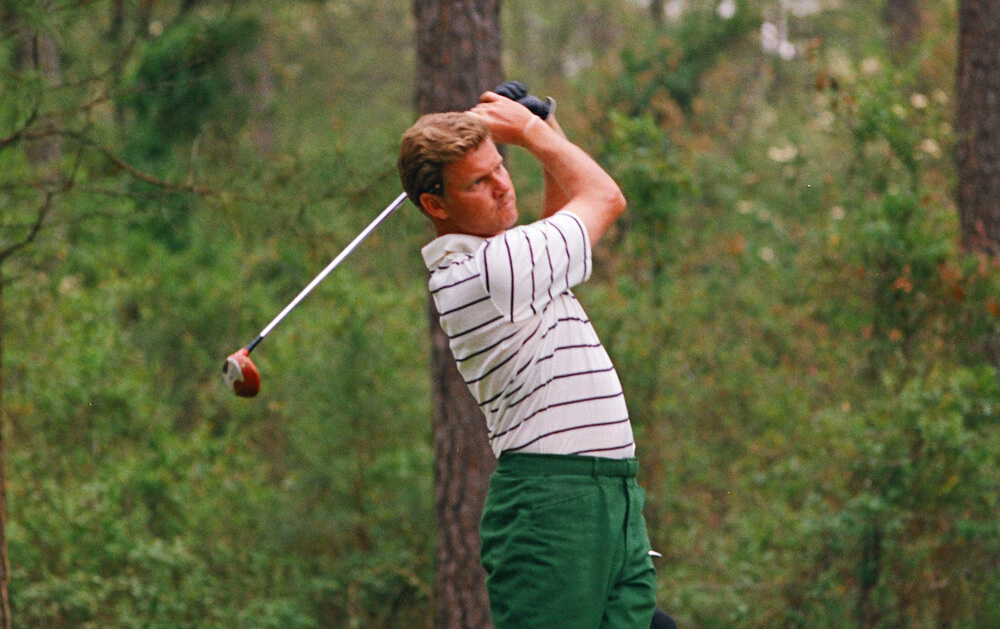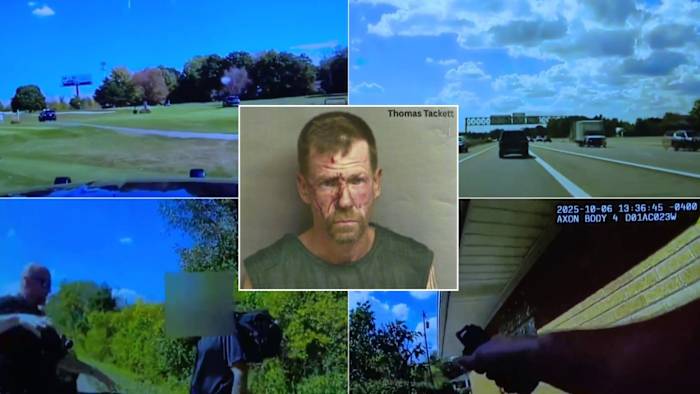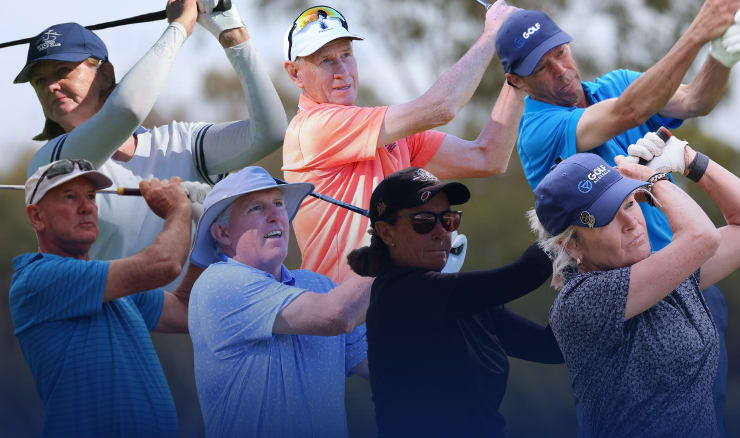On Sunday, June 5, 1966, Eugene Cernan stepped out of the Gemini 9A spacecraft orbiting the Earth. Strapped to his back was a Buck Rogers-like space pack. For the first time, an astronaut would travel in space outside of a capsule and untethered. Unfortunately, Cernan encountered complications, and his helmet visor fogged. Unable to see, he had to return to the capsule without accomplishing that part of the mission.
On Earth, 168 miles below, millions watched the drama unfold on television, among them Bert Yancey, a 27-year-old PGA Tour professional. Six weeks earlier, Yancey had won the Azalea Open in Wilmington, North Carolina, a small-purse PGA Tour event held opposite the Tournament of Champions. Although the Azalea had a modest field, it was his first win and proved he could compartmentalize his mental-health issues – issues about which few were aware – to play at a high level.
Now, though, Yancey was watching the spacewalk in his room at a Ramada Inn in Memphis when he was supposed to be at the Colonial Country Club for the final round of the Memphis Open, featuring luminaries such as Jack Nicklaus, Ben Hogan, and Gary Player. Yancey had matched the course record with a first-round 63, and he trailed Gene Littler by one going into the last round.
Entranced by the spacewalk, Yancey was oblivious to his 11:20 a.m. tee time. As it drew close, tour officials contemplated sending out Bruce Devlin and Dale Douglass as a twosome without him. Tour caddie Roy Stone knew where Yancey was lodging. At 11:05 a.m. Stone called the hotel and told him he had 15 minutes to get to the first tee or be disqualified. Yancey, aghast, sprung into action and sped to the course.
With his sprint from the club parking lot to the first tee serving as his only warm-up, Yancey shot 66 to beat Littler by five strokes. “I was never so frightened,” Yancey said after the round. “I just knew I had blown the whole works.” Years later, he said momentous news events could trigger his episodes – mental demons the severity of which went unknown for years.
Nowadays, you’ve most likely read plenty about professional athletes and mental health, but there was little such discussion in the public sphere until recently, and appallingly little understanding of the subject a half century ago. All of which makes the strange life and remarkable career of Yancey worth re-evaluation.
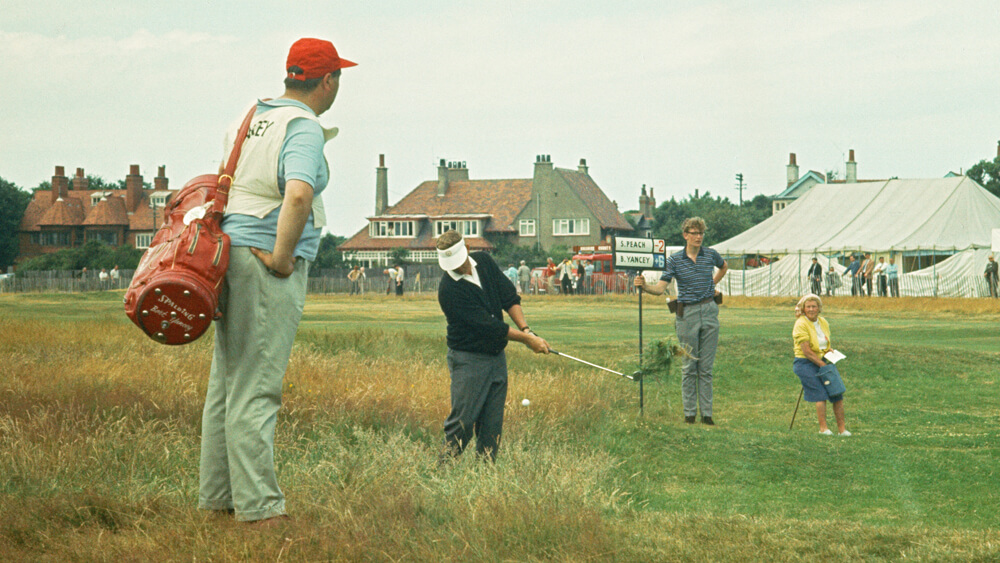 Bert Yancey chips out of the rough during the 1967 Open Championship at Royal Liverpool Golf Club in Hoylake, England. R&A Championships, Getty Images
Bert Yancey chips out of the rough during the 1967 Open Championship at Royal Liverpool Golf Club in Hoylake, England. R&A Championships, Getty Images
Yancey won seven times on the PGA Tour between 1966 and 1972 and came close in several major championships before his career was derailed by mental illness. It was a career he didn’t even want.
“He never aspired to be a professional golfer,” Yancey’s son Scott said in a recent interview. “He wanted to be a doctor.”
Yancey told a Sports Illustrated writer the same thing in 1969 for a profile published before the Masters, where he was one of the pre-tournament favorites. “I wanted to help people,” he said.
“He’s never got the recognition he deserves, particularly with his personal background,” Deane Beman told Global Golf Post. Beman knew Yancey not only from their years playing the tour, but also from Beman’s tenure as tour commissioner, when he dealt with the fallout from Yancey’s illness. Beman observed that Yancey’s record before illness curtailed his career was the equal of or better than that of his friend Tom Weiskopf, who is in the World Golf Hall of Fame.
Given how things turned out for Yancey, with numerous instances of bizarre behavior followed by stays at psychiatric hospitals, being a physician might have been unattainable. However, he did help people, particularly later in his life, when he spoke about his mental-health challenges.
A different time
The human brain has been called the last frontier in medicine. It is the organ integral to our being but remote in terms of scientific understanding, and one of the most difficult to treat when it is not working right.
In 1974, veteran Los Angeles Dodgers’ pitcher Tommy John underwent surgery to reconstruct a torn ligament in his elbow, a condition previously considered career-ending. John returned to pitch 14 more years in the major leagues, and since then countless athletes have benefited from what is now called Tommy John surgery. No such magic treatment has been developed for mental illness. According to multiple studies, deaths by suicide have continued to gradually increase since 1974, even with antidepressants and suicide hotlines.
The travails of gymnast Simone Biles, swimmer Michael Phelps, Major League Baseball players Jarren Duran and Ketel Marte, and tennis player Naomi Osaka have generated a mostly sympathetic response. (A man who heckled Marte about his mother’s death in a vehicular accident was permanently barred from all MLB ballparks.)
Yancey tried to commit suicide in October 1974, foiled only because he couldn’t open a window in a high-rise hotel in Japan.
Star outfielder Jimmy Piersall – whose mental illness was the subject of the 1957 film “Fear Strikes Out” – was a regular target of fan abuse. But the intersection between professional sports and mental health goes back even further, to the 1940 suicide death of Cincinnati Reds backup catcher Willard Hershberger, who took his own life in his hotel room at age 30.
Grayson Murray’s May 25, 2024, suicide was similarly tragic. As with Hershberger, things had appeared to be going well for the 30-year-old PGA Tour pro. Four months earlier, he won the Sony Open in Hawaii, earning nearly $1.5 million, and spoke about his well-documented struggle with depression and alcoholism. Such is the insidious nature of mental illness. More than 50 years ago, when less was known about the brain and treatment options paled in comparison to today, multiple news sources covered Yancey’s dizzying ups and downs, with long features by, among others, the longtime golf writer Dave Kindred and the journalist Mark Mulvoy before he ran all of Sports Illustrated.
Yancey tried to commit suicide in October 1974, foiled only because he couldn’t open a window in a high-rise hotel in Japan. And this, too, happened when things appeared to be going well. He had just earned the biggest check of his career and had been elected by his peers to the prestigious PGA Tour Policy Board.
More so than today, mental illness then came with a stigma, and no one questioned the casual use of words like “crazy” or “deranged.” Odd behavior accompanied by disordered speech could result in an involuntary stay at a psychiatric hospital. Yancey masked his condition well. He was popular among his colleagues and had close friendships with some, who knew nothing about the demons in his mind until they spilled out into his public life.
Change of plans
Albert Winsborough Yancey was born on August 6, 1938. He was raised in Tallahassee, one of 10 children in a family of modest means. His father was a government worker whose purview was, among other things, the Florida roads department.
Yancey was a strapping, handsome youth with thick, straight blonde hair, giving him the appearance of a surfer. He was well-rounded – an Eagle Scout, and extraordinarily bright. At Leon High School, he was a member of the National Honor Society and a class officer in addition to being an outstanding golfer. Upon graduation, Yancey stayed close to home as he enrolled at Florida State University. He also applied for an appointment to the United States Military Academy and was put on the waiting list.
In the spring of 1957, Yancey was ineligible for varsity golf with the Seminoles, but he excelled on the freshman team. By then, he knew his days at Florida State were numbered, because he had been notified by the Army that there was an opening for him at West Point and he intended to take it.
West Point is no stepping stone to the PGA Tour, as it entails several years of service after graduation – proof that being a golf pro was not Yancey’s life plan. Though it meant he would be repeating his first year of college, Yancey reported to West Point in July 1957. He planned to earn an officer’s commission, then go to medical school and serve his country in the Army Medical Department. As a plebe, he played on the golf team and made the dean’s list. After his junior year, he was elected captain. He was undefeated in match play throughout his college career.
“I was still doing things that had no meaning. One day I just started to walk off in a straight line toward the edge of the Everglades. My brother stopped me just in time.”
— Bert Yancey
When Yancey returned to West Point in the summer of 1960 for his final year, he experienced his first known mental-health episode, as per Sports Illustrated. He was unable to sleep and began to rant nonsensically. Yancey lined up plebes in the incoming class and demanded they tell him the meaning of truth, and the meaning of love. He was taken for examination by a psychiatrist, diagnosed as having suffered a “nervous breakdown” and sent to the Army hospital at Valley Forge, Pennsylvania. After nine months there, during which he received electroconvulsive therapy, Yancey took an honorable discharge from the Army on medical grounds.
His plan for an officer’s commission dashed, Yancey returned home to Florida. He moved to Miami to work at a golf course where his brother Jim was the greenkeeper, but he continued to struggle. “It was obvious that I was not well even then,” Yancey said in the 1969 Sports Illustrated profile. “I was still doing things that had no meaning. One day I just started to walk off in a straight line toward the edge of the Everglades. My brother stopped me just in time.”
In July 1961, Yancey decided to make a living as a professional golfer. He took a job as the head pro at Gaffney Country Club in South Carolina and played the PGA winter tour without cashing a single check. He married and won the 1962 South Carolina Open in November. He was 23, and found steadier employment as tournament director for the South Carolina PGA.
But soon thereafter, Yancey abruptly left South Carolina and returned to Florida. He re-enrolled at Florida State to resume his medical studies, but just as quickly, he dropped out. Yancey and his new bride separated and hurriedly divorced after he entered into a relationship with the woman who would become his second wife and the mother of his four children.
During the summer of 1963, Yancey visited a friend in Philadelphia and found a job as an assistant pro at Green Valley Country Club, but he still wasn’t done with tournament golf and all of the accompanying hard knocks. In August, he arrived at the final hole of the Philadelphia Open – a non-PGA Tour event – at Aronimink Golf Club needing only a bogey to win. Instead, he suffered a triple-bogey 7 and finished fourth. However, the following week he rebounded and won the Pennsylvania Open.
Emboldened by his success and resilience, in 1964 Yancey again tried the PGA Tour with the sponsorship of several wealthy Philadelphians. He played in 28 events (often after going through Monday morning qualifying) and made 15 cuts, earning $11,854, a respectable sum back then. He qualified for the U.S. Open, but had to withdraw after gashing his bare foot on a piece of broken glass while hitting a shot from a water hazard. He did better in 1965, earning $22,285, including a runner-up finish at the Phoenix Open. For most of the next decade, by all outward appearances, his mental health would be relatively stable.
In September 1966, after his victories at the Azalea and Memphis opens, Yancey won the Portland Open for his third victory of the year. For 72 holes at Portland, he needed only 102 putts, a tour record that stood until 1977.
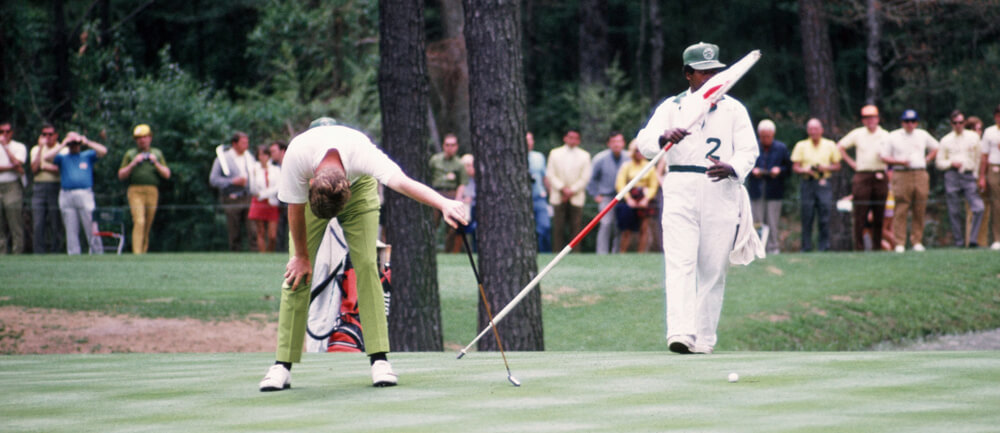 A missed putt in 1970 exemplified Bert Yancey’s unsuccessful attempts to win the Masters. Augusta National, Getty Images
A missed putt in 1970 exemplified Bert Yancey’s unsuccessful attempts to win the Masters. Augusta National, Getty Images
Major factor
Yancey had established himself as one of golf’s brightest young stars, and his victories gave him entrée into his first Masters, in 1967. His opening round of 67 gave him a three-shot lead, and he contended until a final-round 73 left him in third place, four strokes behind winner Gay Brewer.
Winning the Masters became an obsession to Yancey. He created a topographically accurate plaster model of Augusta National the size of a tabletop to aid in his preparation. He never won the Masters, but twice more was close: in 1968, his final-round 65 gave him a backdoor third-place finish, two shots behind winner Bob Goalby (Yancey birdied the par-3 16th hole all four rounds), and in 1970 he was tied for the lead after 36 holes before fading to fourth behind Billy Casper.
Yancey had another close call at the 1968 U.S. Open at Oak Hill. His opening 67 put him in the lead by two shots over Lee Trevino and Charles Coody. After a 68 on Friday, he remained two shots clear of Trevino.
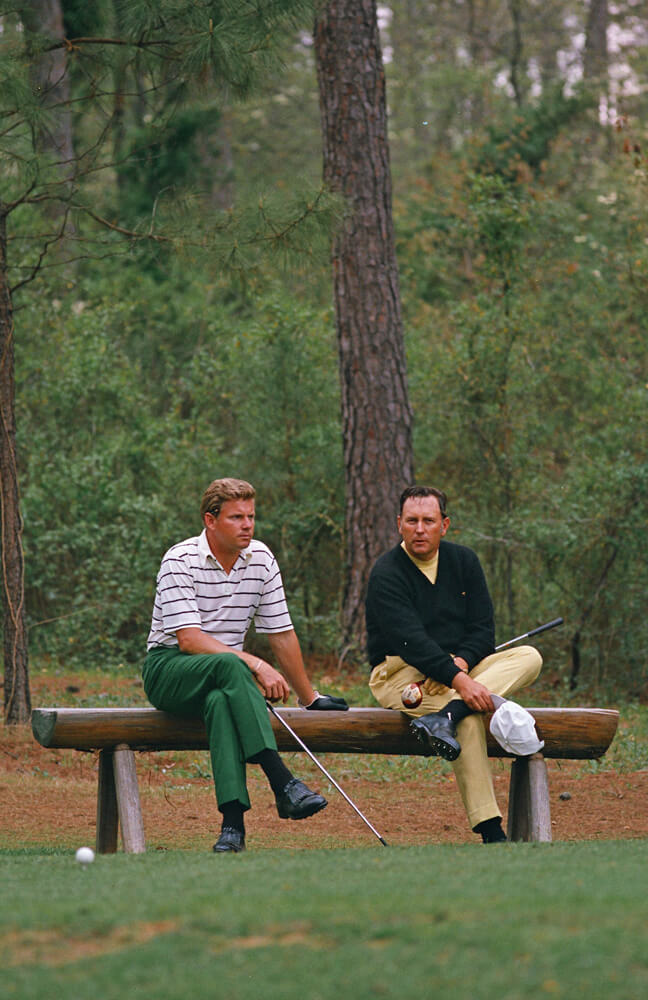 Bert Yancey (left) finished fourth in the 1970 Masters to Billy Casper. Augusta National, Getty Images
Bert Yancey (left) finished fourth in the 1970 Masters to Billy Casper. Augusta National, Getty Images
In the third round, Trevino and Yancey were paired. On the 11th green, Trevino asked Yancey to move his coin marker. After Trevino putted, Yancey placed his ball down, picked up his coin and prepared to putt. Trevino stopped him: “Did you put your coin back?” Yancey had not and re-marked his ball to the correct spot. The pair separated themselves from the field, with Yancey shooting 70 to take a one-stroke lead over Trevino, who shot 69.
“One of these days I’m going to win a big one,” Trevino said after the round. “Maybe I’ll even win this one tomorrow, but I wouldn’t want it because Bert had to take a two-stroke penalty.”
Trevino did win, shooting a 69 while Yancey struggled to a 76 to finish third. According to son Scott, Yancey’s failure at Oak Hill was the biggest disappointment of his career.
Blessed with a near-genius IQ, on airplane flights Yancey enjoyed doing complex math puzzles. “He was a great guy, a brilliant man,” retired pro Frank Beard recalled in an interview. “He taught me to play bridge.”
Tony Jacklin may have been his best friend on the tour. “Bert, Tom Weiskopf and I were inseparable,” Jacklin said. “It was dinner every night and practice rounds the next day. We were as close as friends can be. He was a very deep thinker.”
Through Englishman Jacklin, Yancey developed a love of links golf because of the strategic thinking required. The two stayed together when Jacklin won the 1969 Open Championship at Royal Lytham & St Annes. “The night before the final round, I took a sleeping pill and fell asleep,” Jacklin remembered. “Bert guided me upstairs to my bed.”
Few American pros ventured to the British Isles back then, but Yancey played every Open Championship between 1967 and 1973, making the cut each time and finishing fifth in ’73. Ever since his “nervous breakdown” at West Point in 1960, he had kept his internal problems to himself. Neither Beard nor Jacklin knew their friend suffered from mental illness.
Demons return
“His swing was a symphony, each movement majestic in its purity and simplicity,” Dave Kindred of The Washington Post wrote of Yancey in 1978. “Putting, he was a thief working in daylight, stealing birdies from 20 feet when par was his due.” Among his peers, Yancey was admired as much for his game as for his intellect. “Bert had a simple, three-quarters swing, good tempo,” said Jacklin.
“You could tell he was military by the way he walked down the fairway,” Trevino said. “Like he was marching. He was a tall, good-looking guy, smart, very quiet. He strutted when he went down the fairway. He could really play. He had a beautiful golf swing.”
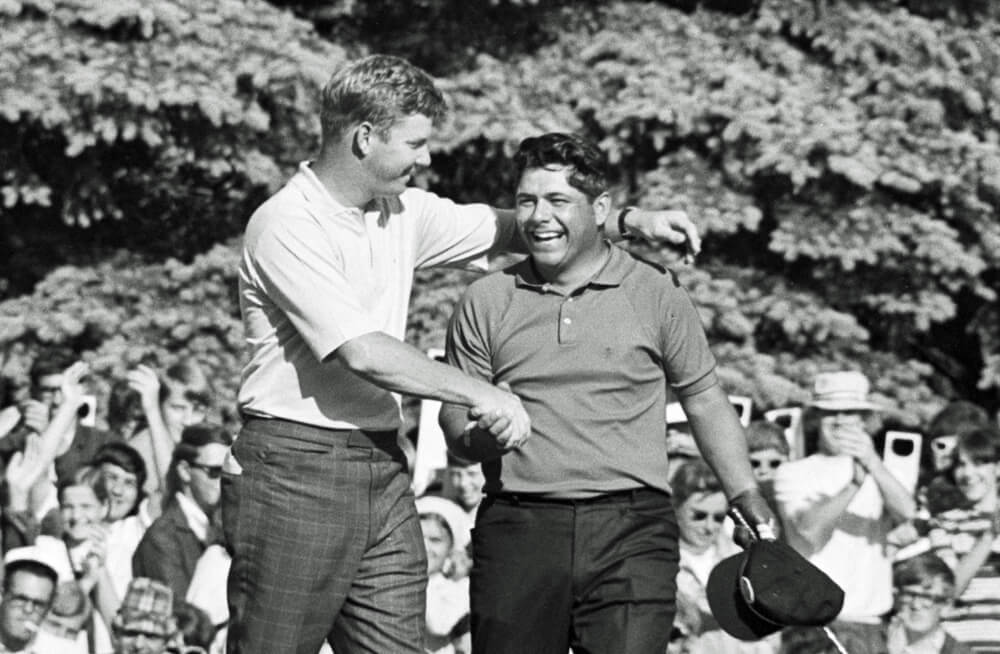 Bert Yancey congratulates Lee Trevino on winning of the 1968 US Open at Oak Hill. Bettmann, Getty Images
Bert Yancey congratulates Lee Trevino on winning of the 1968 US Open at Oak Hill. Bettmann, Getty Images
Fans recognized Yancey for his distinctive pace and ever-present white visor. The last of his seven tour wins was at the 1972 American Golf Classic at Firestone. In 1974, he was second at the Bob Hope Desert Classic and joint third in the U.S. Open at Winged Foot, three strokes behind Hale Irwin.
Four months later, Yancey’s mental health deteriorated. Upon being elected to the PGA Tour Policy Board in October 1974, he traveled to Japan, where he finished second to Littler in a tournament but once again began to behave erratically. Unable to sleep in his Tokyo hotel room, he left at 3 a.m. to visit a Japanese religious shrine. “I was a messiah rising out of the PGA,” Yancey said later. “I was going to the Orient to bring an end to the evil of communism and bring the religions of the Orient into line with Christianity.” As per the story by Kindred, Yancey happened upon members of the Temptations singing group, who were touring Japan, and in light of the group’s name, he believed they must be evil and picked a fight with one of its members. He was felled by a karate chop from one of the group’s entourage before returning to his hotel.
Despite having just earned $32,500, the largest check of his career, Yancey, alone in a foreign country with only his demons to keep him company, tried to escape the only way that seemed available to him. “The only thing that prevented me from jumping from the 40th floor of the Tokyo Hilton was the safety latch on the window wouldn’t release,” he said in 1992. He was taken into custody by Japanese authorities.
From nightmare to stability
Deane Beman, 87, knew Yancey well and counted him as a friend. The two were born just four months apart and bonded over professional golf and other shared interests.
“We had a regular bridge group,” Beman said from a hotel near his summer home in coastal Maine. “Labron Harris was one. Jimmy Colbert, Harold Henning. And of course, Bert. Most of us had families that didn’t travel with us on tour. We played bridge almost every night.” Like Beard and Jacklin, Beman had no idea his friend suffered from mental illness.
At the time of Yancey’s episode in Tokyo, the PGA Tour had no player assistance program, but in Beman, Yancey had the next best thing. Seven months earlier, Beman – retired as a player – became the second commissioner of the PGA Tour. And as it happened, he had a brother who suffered from bipolar disorder.
“When I became commissioner of the tour, I was very much aware of this illness, and I was involved with Bert as a friend and as a commissioner in handling some of the problems that he had,” Beman said.
According to Beman, Japan was not enlightened to mental illness. “I don’t know how their attitude is today, but it was a problem to actually get him out of the hands of the officials there,” Beman said. Because of Yancey’s record of service in the Army, Beman was able to arrange for Yancey’s release and to get him on a military airplane back to the United States. Yancey was hospitalized in Philadelphia for two-and-a-half months, and released with no definitive diagnosis and no follow-up plan. He returned to the tour in 1975 with no apparent ill effects, finishing second behind Nicklaus at Doral, and second at Tallahassee.
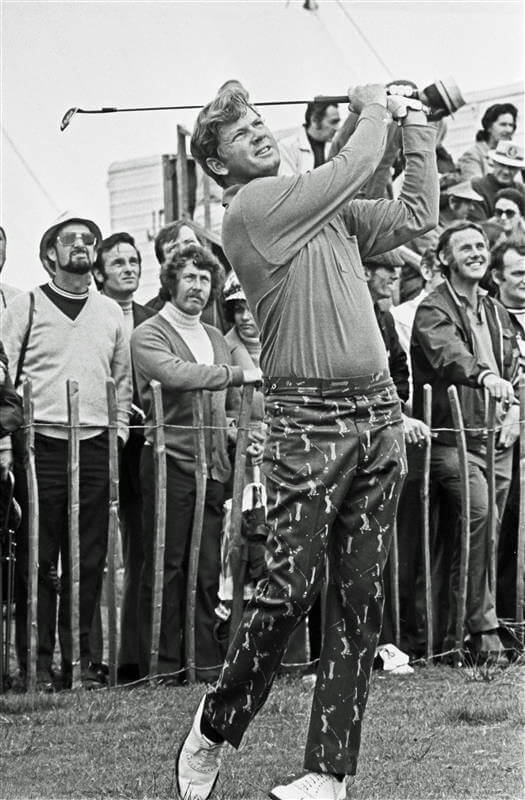 Bert Yancey played in every Open Championship from 1967 through the 1973 tournament at Troon, in Scotland. Evening Standard/Hulton Archive, Getty Images
Bert Yancey played in every Open Championship from 1967 through the 1973 tournament at Troon, in Scotland. Evening Standard/Hulton Archive, Getty Images
In retrospect, this was a false dawn, for in August, after the final round of the Westchester Classic, played in 100-degree heat, there was another incident, this time at LaGuardia Airport. As per Kindred, Yancey ordered a painter to get down from a ladder, which Yancey then climbed up before launching into a speech on the evils of racism. To much laughter, he directed Black passengers to move to one side and white passengers to the other. He was taken into custody and transported to the Payne Whitney Psychiatric Clinic in Manhattan.
Within two days, Yancey was diagnosed with manic-depressive illness (bipolar disorder), a condition marked by alternating periods of depression and abnormally elevated moods. During depressive periods, the sufferer is prone to suicidal thoughts, as was the case for author Ernest Hemingway in 1961 and Washington Post publisher Phil Graham in 1963, both of whom died by suicide. Yancey finally knew what was wrong.
Lithium, which the Food and Drug Administration had approved for treatment of bipolar disorder in 1970, stabilized his mood for periods. However, with regular usage, lithium causes hand tremors. In 1976, Yancey (by then 37 years old) gave it a try, but in 12 PGA Tour events did not make a single cut and had a scoring average of 79.77.
At the Heritage Classic, he was in a threesome with Nicklaus. In the first round, he shot 90. His 12-year-old son Charles was in the gallery and heard a spectator say, “Yancey stinks. He shouldn’t be out there with Nicklaus.” Charles hit the man over the head with a stick and ran off with the stick (according to Scott, thereafter his father displayed the stick on a table at his home). In July, Yancey was paired with Weiskopf for the first two rounds at Westchester. Neither played well (Yancey shot 80-81) and Weiskopf walked off the course during the second round and was fined $3,000 by the PGA Tour. Weiskopf (who died in 2022) later gave a reason, saying his friend was behaving erratically and disturbing him with verbal barbs.
As nightmarish as 1974 to 1976 were, 1977 was even worse. Yancey retired from competitive golf and established the Bert Yancey Classical School of Golf at Hilton Head Island, South Carolina. His second wife filed for divorce and for custody of their four children, and Yancey, who yearned to return to playing, stopped taking lithium.
As per multiple news accounts, on Oct. 31 at 1 a.m., the Beaufort County Sheriff’s Department received a call from a woman claiming there was a prowler outside her home, which was next door to Yancey’s residence. Yancey – wearing a Robin Hood costume for Halloween – was seen by deputies peering into a rear window and was apprehended. In the patrol car, he became violent and caused damage to the vehicle’s interior. He was arrested and charged with violating the Peeping Tom law, indecent exposure, resisting arrest, and destruction of property. He was transferred to the state psychiatric hospital in Columbia in a straitjacket. In December, Yancey was released when he voluntarily admitted himself to a private facility. He admitted to being on a manic high but denied that he exposed himself. The charges were dropped, and he kept his position at Hilton Head.
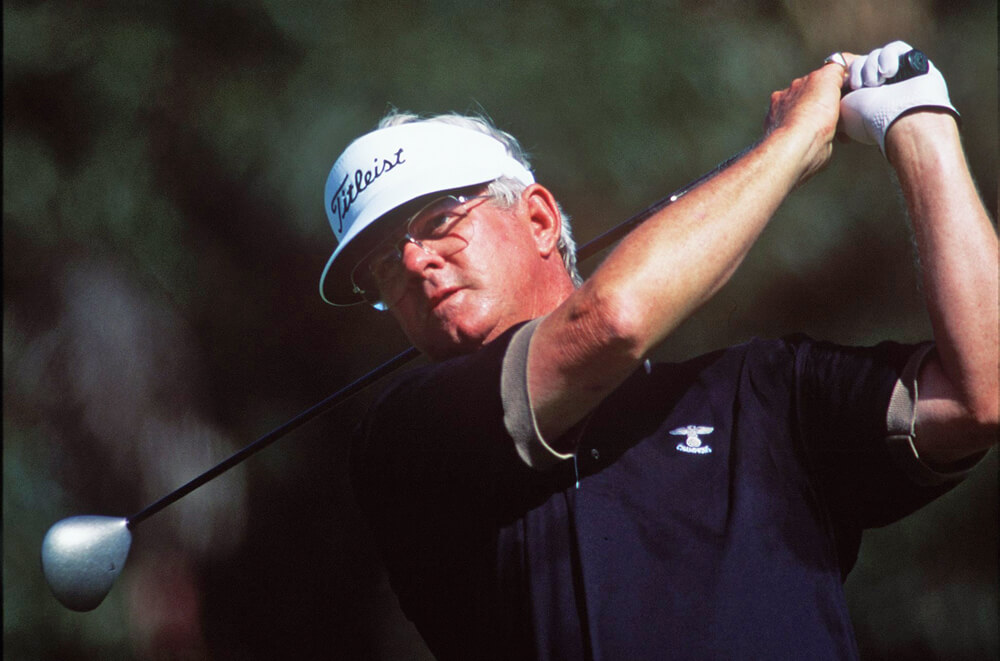 Bert Yancey, here playing in the 1993 GTE West Classic, joined the Senior PGA Tour in 1988. Gary Newkirk/ALLSPORT, Getty Images
Bert Yancey, here playing in the 1993 GTE West Classic, joined the Senior PGA Tour in 1988. Gary Newkirk/ALLSPORT, Getty Images
Yancey began to speak about his mental illness, including to Kindred, whose syndicated story was widely distributed in the spring of 1978, and to NBC television personality Tom Snyder in a June 1978 segment titled “Escape from Madness.”
Into the 1980s, Yancey continued to work at Hilton Head. In March 1982, he intended to play in the Heritage Classic on his home course, but before he was scheduled to tee off in the first round, he demonstrated erratic behavior and was escorted off the course into the care of his physician and hospitalized. Long periods of stability, with intermittent hospitalizations in between (approximately 20 in all), was Yancey’s new normal.
In the mid-1980s, Yancey’s doctors switched him from lithium to Tegretol and Depakote. They were effective, and without the tremor side effects. In the fall of 1986, at 48, he played a Florida mini-tour and entered the Tallahassee Open. After opening with 77, he shot 69 to make the cut. He finished in a tie for 52nd and earned $468, his first tour paycheck since 1975.
In August 1988 – when Yancey turned 50 – he became an enthusiastic member of the Senior PGA Tour (now PGA Tour Champions). He was not a star, but he earned a paycheck every week. His best year was 1992, when he had four top-10 finishes and earned $118,844. (That eclipsed his best years on the PGA Tour, in which he never earned more than $85,000.) More importantly, Yancey made time to speak to mental-health groups amid his busy playing schedule. “He would speak for two or three hours, and nobody would leave,” son Scott recalled. “At some point I realized he was more about setting a good example than winning.” When Yancey spoke to groups, he would say, “It’s OK to be mentally ill.”
Admirable legacy
August 26, 1994, was a crystalline morning in Park City, Utah. Yancey, 56, was scheduled to tee off at 10:20 a.m. for the first round of the Franklin Quest Championship when he saw his friend Weiskopf in the clubhouse at Park Meadows Country Club. “Play good, T,” he said to Weiskopf, who would tee off in the threesome following Yancey’s. “I’ll see you at lunch.”
Yancey felt discomfort in his chest and arm as he warmed up and talked to paramedics stationed at an onsite ambulance by the range. His blood pressure was slightly elevated, but he said he felt better, and he was reluctant to withdraw. He doubted there would be time for officials to summon an alternate to take his place in the field, and he felt an obligation to his playing partners, Rives McBee and Jim Albus, to avoid having to play a slow round as a twosome.
After returning to the practice range, Yancey hit several balls before realizing he could not continue. Suddenly, he collapsed.
“I hope his legacy is that he tried to help people.”
— Scott Yancey
In a 2022 article, Laury Livsey of PGA Tour Champions related that, as paramedics were placing Yancey on a stretcher, he grabbed the hand of rules official Bryan Naugle and asked, “Did the first alternate get in?” Those were his last words; he went into cardiac arrest and efforts to revive him were unsuccessful. Park Meadows head pro Mike Kutcher overheard the exchange between Yancey and Naugle. “The poor guy is having a heart attack,” Kutcher recalled, “and his biggest concern is getting the first alternate into the field.”
A grief-stricken Weiskopf wanted to withdraw but soldiered on and won. “It means so much to me to win this trophy for Bert,” he said. Jacklin also played and finished seventh. The following year before the Franklin Quest Championship, a rock monument to Yancey was unveiled at Park Meadows Golf Club. Jacklin attended the ceremony and went on to win.
Although it was a heart attack, not mental illness, that ended Yancey’s life, his legacy is more closely connected to mental health than heart disease or anything else. He never conquered mental illness, but in an era when it was still poorly understood, he refused to let it defeat him and died with his golf spikes on. He founded an advocacy group, Birdies, Bogeys & Bert, which held a tournament in Augusta, Georgia, to raise money for mental-health organizations. The topsy-turvy life of the talented Bert Yancey is a sobering reminder of the old saw that it’s not so much what you accomplish in life but what you overcome.
“I hope his legacy is that he tried to help people,” son Scott said. And indeed he did try to help them, until his last breath – “Did the first alternate get in?” – but only after first helping himself. That he was able to do so was the greatest challenge, and the greatest accomplishment, of his life.
If you are thinking about harming yourself or attempting suicide, tell someone who can help right away. Call 988 (the Suicide & Crisis Lifeline) 24 hours a day and you will talk to somebody within minutes, or call 911 for emergency services, or go to the nearest emergency room.
Patrick Hand is a freelance writer and contributor to Global Golf Post, and is the author of “The Age of Palmer: Pro Golf in the 1960s, Its Greatest Era” (Canoe Tree Press 2023).
Top: Bert Yancey tees off on the 11th hole during the 1970 Masters. Augusta National, Getty Images
© 2025 Global Golf Post LLC

